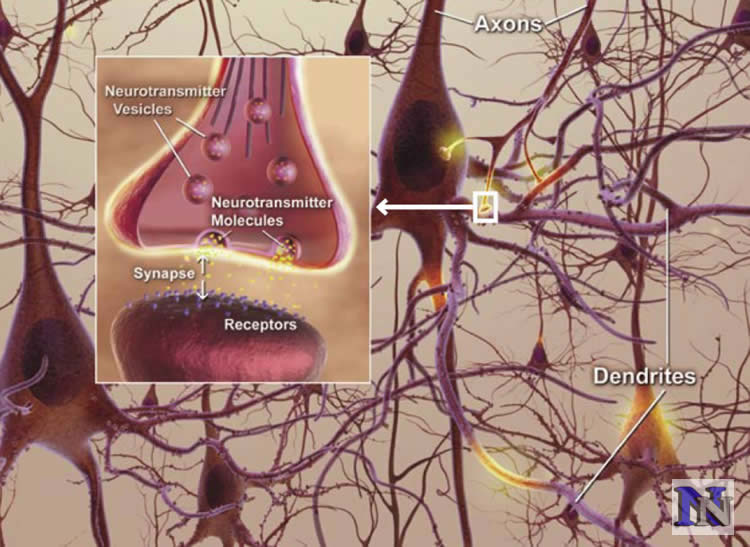A team of researchers led by UNSW Australia scientists has discovered how connections between brain cells are destroyed in the early stages of Alzheimer’s disease – work that opens up a new avenue for research on possible treatments for the degenerative brain condition.
“One of the first signs of Alzheimer’s disease is the loss of synapses – the structures that connect neurons in the brain,” says study leader, Dr Vladimir Sytnyk, of the UNSW School of Biotechnology and Biomolecular Sciences.
“Synapses are required for all brain functions, and particularly for learning and forming memories. In Alzheimer’s disease, this loss of synapses occurs very early on, when people still only have mild cognitive impairment, and long before the nerve cells themselves die.
“We have identified a new molecular mechanism which directly contributes to this synapse loss – a discovery we hope could eventually lead to earlier diagnosis of the disease and new treatments.”
The team studied a protein in the brain called neural cell adhesion molecule 2, or NCAM2 – one of a family of molecules that physically connects the membranes of synapses and help stabilise these long lasting synaptic contacts between neurons.
The research is published in the journal Nature Communications.
Using post-mortem brain tissue from people with and without the condition, they discovered that synaptic NCAM2 levels in the part of the brain known as the hippocampus were low in those with Alzheimer’s disease.

They also showed in mice studies and in the laboratory that NCAM2 was broken down by another protein called beta-amyloid, which is the main component of the plaques that build up in the brains of people with the disease.
“Our research shows the loss of synapses is linked to the loss of NCAM2 as a result of the toxic effects of beta-amyloid,” says Dr Sytnyk.
“It opens up a new avenue for research on possible treatments that can prevent the destruction of NCAM2 in the brain.”
The study’s first author is Dr Iryna Leshchyns’ka of the UNSW School of Biotechnology and Biomolecular Sciences and the team includes researchers from Neuroscience Research Australia and the Dementia Research Unit of the UNSW School of Medical Sciences.
Funding: The study was funded by Australia’s National Health and Medical Research Council, Rebecca L. Cooper Medical Research Foundation, Sydney Brain Bank.
Source: Dr. Vladimir Sytnyk – University of New South Wales
Image Source: The image is in the public domain
Original Research: Full open access research for “Aβ-dependent reduction of NCAM2-mediated synaptic adhesion contributes to synapse loss in Alzheimer’s disease” by Iryna Leshchyns’ka, Heng Tai Liew, Claire Shepherd, Glenda M. Halliday, Claire H. Stevens, Yazi D. Ke, Lars M. Ittner and Vladimir Sytnyk in Nature Communications. Published online November 27 2015 doi:10.1038/ncomms9836
Abstract
Aβ-dependent reduction of NCAM2-mediated synaptic adhesion contributes to synapse loss in Alzheimer’s disease
Alzheimer’s disease (AD) is characterized by synapse loss due to mechanisms that remain poorly understood. We show that the neural cell adhesion molecule 2 (NCAM2) is enriched in synapses in the human hippocampus. This enrichment is abolished in the hippocampus of AD patients and in brains of mice overexpressing the human amyloid-β (Aβ) precursor protein carrying the pathogenic Swedish mutation. Aβ binds to NCAM2 at the cell surface of cultured hippocampal neurons and induces removal of NCAM2 from synapses. In AD hippocampus, cleavage of the membrane proximal external region of NCAM2 is increased and soluble extracellular fragments of NCAM2 (NCAM2-ED) accumulate. Knockdown of NCAM2 expression or incubation with NCAM2-ED induces disassembly of GluR1-containing glutamatergic synapses in cultured hippocampal neurons. Aβ-dependent disassembly of GluR1-containing synapses is inhibited in neurons overexpressing a cleavage-resistant mutant of NCAM2. Our data indicate that Aβ-dependent disruption of NCAM2 functions in AD hippocampus contributes to synapse loss.
“Aβ-dependent reduction of NCAM2-mediated synaptic adhesion contributes to synapse loss in Alzheimer’s disease” by Iryna Leshchyns’ka, Heng Tai Liew, Claire Shepherd, Glenda M. Halliday, Claire H. Stevens, Yazi D. Ke, Lars M. Ittner and Vladimir Sytnyk in Nature Communications. Published online November 27 2015 doi:10.1038/ncomms9836






